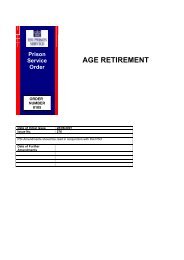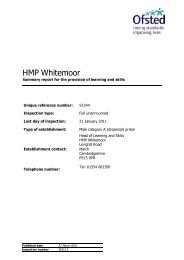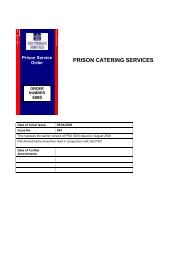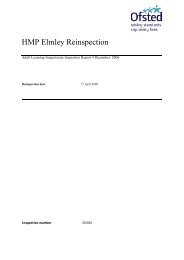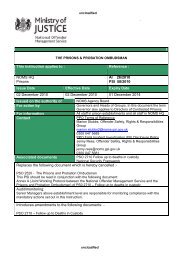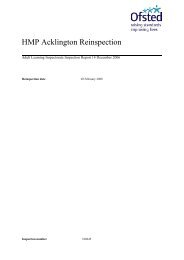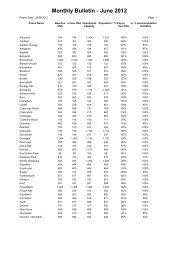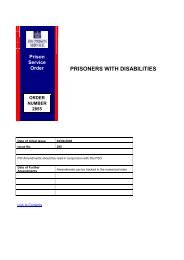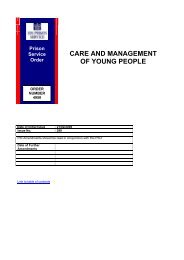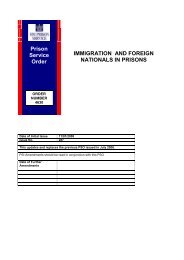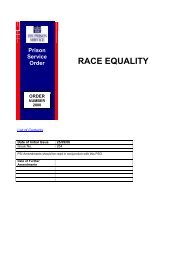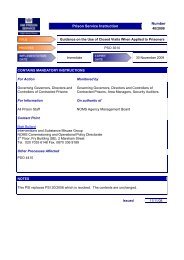UNCLASSIFIED PAGE 27ANNEX DFURTHER GUIDANCE ON THE HANDLING ARRANGEMENTS FOR PRISONERS’ LEGAL ANDCONFIDENTIAL ACCESS CORRESPONDENCEIntroduction1. The purpose of this annex is to provide detailed guidance on the handling arrangementsfor legal and confidential access correspondence between prisoners and their legaladvisers, and with the courts. This correspondence is covered by Prison Rules 35A & 39and YOI Rules 11 & 17 and applies to all prisoners, including Category A, youngoffenders and remand prisoners. It should also be read in conjunction with the guidancegiven in the National Security Framework, under Function 4 – Interception ofCommunications, which covers the security procedures for dealing with legal/confidentialaccess correspondence.2. All correspondence, including legally privileged documents/material which is handed overduring the course of a legal visit, between prisoners, their legal advisers and the Courts(including the European Courts) must be treated as privileged by virtue of Prison Rules38 & 39 and YOI Rules 16 & 17. Such correspondence/documents/material cannot beopened, read or stopped except in the specific circumstances set out in Rules 35A andYOI Rules 11.3. Furthermore all correspondence between prisoners and the bodies listed in paragraph14.1(b) of this <strong>PSI</strong> must be given the same degree of confidentiality.Action for Governors4. There must be strict compliance with the rules regarding privileged and confidential mail.Any breach, even if accidental, is likely to lead to legal challenge in both the domestic andinternational courts. Governors should ensure that the guidance contained in this annexis brought to the attention of all staff that process prisoners‟ correspondence and take thenecessary steps to ensure that the confidentiality of prisoners‟ correspondence underthese provisions is maintained at all times. Governors should pay particular regard toensuring that there are sufficient safeguards to avoid the possibility of suchcorrespondence being opened inadvertently.Outgoing Correspondence – Examination/Opening5. Prisoners should be informed that correspondence addressed to their legal advisers, or toany Court including the European Court of Human Rights and the European Court ofJustice can be handed in sealed for despatch, provided that the words “Prison Rule 39” or“YOI Rule 17” and the prisoner‟s name are written on the back of the envelope. Nonlegalletters addressed to bodies/individuals to which prisoners can write confidentiallyshould be marked “Confidential Access”.6. There may be occasions where, due to oversight or lack of awareness, correspondencemay not be clearly marked in this way or may be left unsealed. Nonethelessestablishments should note that, where correspondence is identified as being addressedto a recognisable legal adviser or body to whom confidential access status applies, itshould be treated in exactly the same way as if it were properly marked and sealed.7. On receipt of a letter for despatch, the correspondence officer should check whether thename and address is that of a legal adviser or a court or a body listed in paragraph 14.1.A legal adviser will usually be identifiable from the name and address of a sole<strong>PSI</strong> 49/<strong>2011</strong> UNCLASSIFIED ISSUE DATE 26/09/<strong>2011</strong>
UNCLASSIFIED PAGE 28practitioner or firm of practitioners, but may also for example be employed by anotheradvisory body such as the Prisoners‟ Advice Service, Liberty or Citizen‟s Advice Bureauor may even practice from their home address. However, in cases of doubt it may benecessary to contact the legal adviser concerned to obtain confirmation of their status orseek verification from the Law Society.8. The Officer should also consider whether any examination for illicit enclosures isnecessary. An “illicit enclosure” is defined in the Prison Rule 39(6) as including anyarticle possession of which has not been authorised in accordance with Prison Rules andany correspondence to and from a person other than the prisoner, their legal adviser or acourt (including the various European courts). However, prisoners may include relevantenclosures in Rule 39 mail to third parties e.g. to the Legal Services Commission thatthey wish their solicitor to transmit on their behalf.9. In any case where there are reasonable grounds to suspect that the letter contains anillicit enclosure, arrangements should be made to open the letter in the presence of theprisoner concerned unless that prisoner declines the opportunity to be present (in whichcase the prisoner should be asked to sign a waiver). This must be decided on a case bycase basis (see paragraphs 14.2 (c) – 14.2 (d) in main <strong>PSI</strong> above). If the envelope isthen found to contain an illicit enclosure, this should be removed and referred to theGovernor for further action.10. Where an illicit enclosure has been removed from a letter, the prisoner must be informed.He or she should then be provided with another envelope in which to place thecorrespondence, minus the removed illicit enclosure. The prisoner should be asked toaddress it to the legal adviser and seal it in the presence of a member of staff, ready fordespatch. The correspondence officer must not read the letter, which should bedespatched unless it is passed to the Governor under paragraphs 16 to 20 below.11. Both the decision and the reasons for examining the correspondence must be recordedclearly on the prisoner’s record.Incoming Correspondence – Examination/Opening12. Incoming correspondence should be in a double envelope enclosing a letter sealed in anunstamped envelope, the outside of which will be annotated with the prisoner‟s name andprison number (if known); the name, address and telephone number of the law firm and areference number; the words “Prison Rule 39” or “YOI Rule 17”; and the signature of thelegal adviser or his or her clerk (or appropriate official in the case of confidential accesscorrespondence). Alternatively, this information may be given in a covering letter to theGovernor rather than written on the envelope addressed to the prisoner. All mail receivedfrom the European Commission or the European Courts is readily identifiable, i.e. theenvelope is clearly stamped, bearing the words “European Commission, Strasbourg” or“European Court of Justice” in both English and French.13. There will be occasions when, due to oversight or lack of awareness by the author, anincoming letter may not be clearly marked in this way. Nonetheless where incomingcorrespondence appears as if it has come from a legal adviser (for example by asolicitor‟s stamp on the envelope or by some other marking such as “legalcorrespondence – privileged”) or from an organisation entitled to confidential access, itshould be treated in exactly the same way as if it were properly marked. In those caseswhere mail is received from a legal adviser employed by organisations such as Prisoners‟Advice Service, Liberty or Citizen‟s Advice Bureau the same procedure will apply.14. Where there is reason to believe that the letter has not originated from a genuine source,the prison should check directly with the firm or body or individual concerned. In theevent of the letter being found to be from a source other than the one which would be<strong>PSI</strong> 49/<strong>2011</strong> UNCLASSIFIED ISSUE DATE 26/09/<strong>2011</strong>



